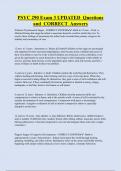PSYC 290 Exam 3 UPDATED Questions
and CORRECT Answers
Erikson's Psychosocial Stages - CORRECT ANSWER✔✔- Birth to 12 mos. - Trust vs.
Mistrust:During this stage the infant is uncertain about the world in which they live. To
resolve these feelings of uncertainty the infant looks towards their primary caregiver for
stability and consistency of care.
12 mos. to 3 years - Autonomy vs. Shame & Doubt:If children in this stage are encouraged
and supported in their increased independence, they become more confident and secure in
their own ability to survive in the world.If children are criticized, overly controlled, or not
given the opportunity to assert themselves, they begin to feel inadequate in their ability to
survive, and may then become overly dependent upon others, lack self-esteem, and feel a
sense of shame or doubt in their own abilities.
3 years to 6 years - Initiative vs Guilt: Children explore the world beyond themselves. They
explore feeding and dressing, toilet training, and new ways of moving about. When they
begin to succeed in doing things for themselves, they gain a sense of self-confidence and self-
control. However, if they continually fail and are punished or labeled as messy, sloppy,
inadequate, or bad they learn to feel shame or self-doubt.
6 years to 12 years - Industry vs. Inferiority: Children develop numerous skills and
competencies in school, at home, and in the outside world. A sense of self is enriched by the
realistic development of such competencies. Comparison with peers is increasingly
significant. A negative evaluation of self as inferior compared to others is especially
disruptive at this time.
12 years to 18 years - Ego identity vs. Ego diffusion: Before adolescence, children begin to
learn a number of different roles: student, friend, older sibling, athlete, musician, and so forth.
During adolescence, it becomes important to sort out and integrate those roles into a single,
consistent i
Piaget's Stages of Cognitive Development - CORRECT ANSWER✔✔- Birth to
approximately 2 years: Sensorimotor - Infants learn about the world through looking,
grasping, mouthing, and other actions. Intelligence relies on the senses and bodily motion,
beginning with simple reflexes that give rise to more complex, voluntary behaviors.
, 2 years to approximately 7 year: Preoperational - Children form concepts and use symbols,
such as language, to help them communicate. Such concepts are limited to their personal,
immediate experiences. Preoperational children possess very limited, and at times "magical",
notions of cause and effect and have difficulty classifying objects or events. They do not hold
broad, general theories, but instead they use daily experiences to build specific knowledge. In
addition, preoperational children neither make generalizations about classes of objects (e.g.,
all grandmothers) nor can they think through the consequences of a particular chain of events.
7 years to 11 or 12 years: Concrete operational - Children begin to think logically, to classify
on more than one dimension at a time, and to understand mathematical concepts provided
they can apply these operations to concrete or at least concretely imaginable objects or
events. Concrete operational children begin to use logic in their thinking, but they may
experience difficulty in understanding that a particular animal can be both a "dog" and a
"terrier", and they can deal with only one classification at a time. Yet 7-year-olds understand
that terriers are a smaller group within the larger group, dogs. They can also see other
subgroups such as terriers and poodles as "small dogs" and goldren retriever and st. bernards
as "large dogs". Thsi kind of thinking shows an understanding of heirarchy in classification.
12 years and beyond: Formal operational - Individuals can explore logical solutions to both
conc
Characteristics of Middle Adulthood - CORRECT ANSWER✔✔- Sensation:
- Decline in visual acuityl, except for distant objects
- Hearing loss, especially for high-frequency sounds
- Decline in taste
Reaction Time:
- Slow decline in reaction time
Internal Changes:
- Slowing of the nervous system
- Stiffening and shrinking of the skeleton
- Loss of elasticity in the skin and the muscles; development of wrinkles
- Accumulation of subcutaneous fat
- Decrease in heart and lung capacity




